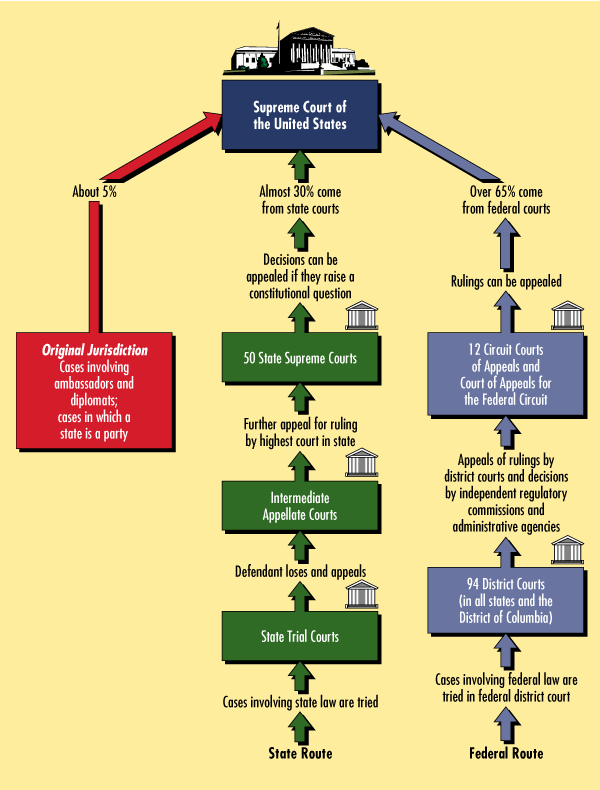How does a case get to the Supreme Court?
Critical Analysis
Find answers to the following questions using the visual above, any links below, your big brain, and your knowledge of American government and politics:
Cases that go to the Supreme Court are either cases of original jurisdiction - which begin at the Supreme Court, or they are cases of appellate jurisdiction - that are appealed from lower court decisions. What portion of cases that make it to the Supreme Court come through appellate jurisdiction?
The American judicial system is federal - divided between state courts and federal courts. State courts hear cases involving state laws. Federal courts hears cases involving federal laws. About what percent of Supreme Court cases come from state courts?
What kind of cases from state courts make it to the U.S. Supreme Court?
A third course of cases heard by the Supreme Court are known as cases of original jurisdiction - which begin at the Supreme Court. Article III of the U.S. Constitution gives the Supreme Court original jurisdiction over several small but important categories of cases:
Cases affecting ambassadors, other public ministers, and consuls;
Cases of admiralty and maritime jurisdiction;
Controversies in which the United States is a party;
Controversies between two or more states;
Controversies between a state and citizens of another state;
Controversies between citizens of different states;
Controversies between citizens of the same state claiming lands under grants of different states, and between a state, or the citizens thereof, and foreign states, citizens or subjects.
In these cases, parties bring their disputes directly to the high court, bypassing all lower courts. About what percent of cases that go to the Supreme Court involve original jurisdiction?
There are 94 different federal district courts in the United States. The majority of these cases occur when a specific federal law has been violated. For example federal courts might hear a case regarding IRS (tax) violations, U.S. mail fraud, drug trafficking/drug possession, kidnapping, counterfeiting bills, immigration crimes, copyright infractions. If parties in a case do not like a ruling from a federal court they can appeal the case to U.S. federal appeals courts. How many federal appeals courts are there?
What is the only court that can hear appeals of rulings from the federal appeals court?
On average, the Supreme Court accepts about 100-150 of the more than 7,000 cases that it is asked to review each year. Why do so few cases make it to the Supreme Court?
Why do you think we call it the Supreme Court?
Article III, section 1 set up the U.S. federal court system: “The judicial Power of the United States, shall be vested in one supreme Court, and in such inferior Courts as the Congress may from time to time ordain and establish. The Judges, both of the supreme and inferior Courts, shall hold their Offices during good Behaviour…” Besides misspelling behavior, what branch did the Framers give the power to create all the other federal courts below the Supreme Court?
On May 28, 1788, Alexander Hamilton published Federalist 78—titled “The Judicial Department.” In this famous Federalist Paper essay, Hamilton emphasized the importance of the power of judicial review. How is the concept of judicial review illustrated in the visual above?
Write and Discuss
Take ten minutes to write about the question at the top of the page and then discuss with your classmates.
Learn More
Read more about the Structure of the Federal Courts.
Act on your Learning
Article III of the United States Constitution outlines Congress's power to oversee the judiciary and to create inferior (below the Supreme Court) courts. Contact Senator Dick Durbin chair of the Senate Judiciary Committee, and share your thoughts about whether the Congress should alter the number of federal courts.
Get Creative
If the Supreme Court was a character from Harry Potter, what character would they be and why?


